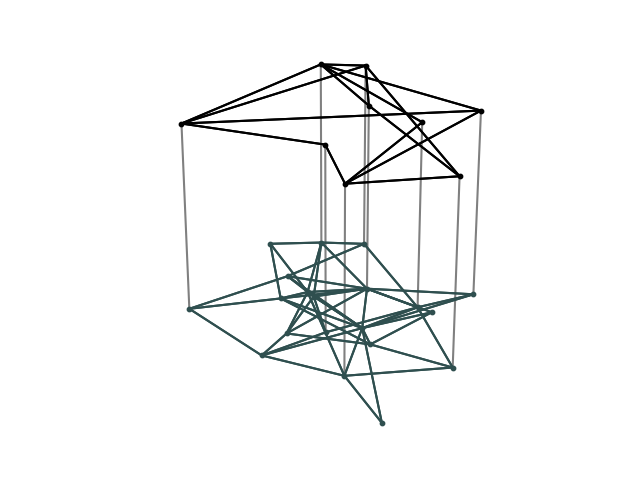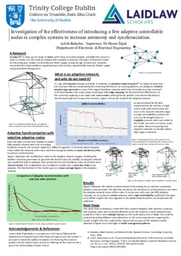Exploring the fascinating science of Networks


"Nature uses only the longest threads to weave her patterns, so each small piece of her fabric reveals the organization of the entire tapestry." - Richard Feynman
In the vast realm of network science lies a captivating challenge: achieving synchronization within a complex system using adaptive network systems with limited coverage. Embarking on this research project, I was drawn to the allure of multilayer adaptive networks, offering a dynamic avenue for exploration. The complexities of this uncharted territory presented an opportunity to delve deeper into the potential of this unique approach, seeking to unravel the enigmas at the intersection of synchronization and limited network coverage. With all this is mind I embarked on this data-packed voyage as I ventured into unexplored domains, aiming to comprehend the extraordinary intricacies of our interconnected world.
Throughout this research summer, I had the extraordinary opportunity to explore the captivating realm of networks. While some aspects came surprisingly easy, others proved to be quite challenging. One realization I've gained from this experience is my struggle with Gantt Charts. What I anticipated as time-consuming tasks turned out to be manageable, but seemingly straightforward processes took weeks to complete.
The journey began with the most formidable obstacle - the learning phase. To produce valuable research, I had to immerse myself in the cutting-edge field of network science. Spending nearly a week and a half acquainting myself with Barabasi's work and adopting his analytical perspective on the world was both humbling and enlightening. Each day spent in the undergrad lab at Trinity's Electronic Department shaped a unique perspective that allowed me to conduct my research while embarking on a thought-provoking journey into the vast world of network modelling. It became clear how such thinking could lead to distinctive problem-solving approaches, unlocking new avenues for exploration. The big fear at this stage was the lack of clarity of how my results would look like and whether my hypothesis was even somewhat reasonable. Dr. Harun Ŝiljak, my research supervisor, wisely said, "That’s research," reminding me to embrace uncertainty.
Surprisingly, setting up my network experiments proved remarkably straightforward, thanks to the contributions of many researchers in the field. By the end of week 2, I successfully modelled a two-layered adaptive network system and simulated the creation and removal of links using the edge snapping technique, contingent on the demand in specific parts of the network. My first model aimed to visualize the necessity of adaptive network systems.
Following an enlightening conversation with Dr. Ŝiljak, I delved into the intricacies of the Lorenz oscillator, known for generating periodic polar states of significant magnitude. Implementing this oscillator as the demand on one of the network nodes allowed me to mimic varied traffic over time and visualize the doubling of average error throughout the network and the resulting strain caused.
By then increasing the adaptability constant, which controlled the effectiveness of my adaptive network, I was able to decrease this error significantly to a negligible amount. This finding built a strong case for having adaptive systems on top of the networks we depend on so dearly, including electricity, water, and transport.
Next, I focused on addressing how to cope with differences in state in the network, considering that not all nodes of the network have adaptive nodes above them. This challenge meant that while our network wouldn't synchronize with ease as when tested above, strategically placed adaptive networks could still offer near-zero synchronization error within the network.
With this goal for my research project, I delved into implementing this design using Python for the next couple of weeks. I encountered numerous bugs, value errors, and long processing times, making it hard to comprehend the data. After compiling my program, I spent tedious hours running it multiple times, changing different parameters to visualise the change, ensuring all data was appropriate and not out of range, and compiling it all into one massive CSV file. While it was a taxing week, it was the most important part of my research, since this is where I collected all my data, compared different node selection patterns, determined its viability and most importantly observed the results that were brought from the selection, and the satisfaction I gained at the very end when I created my graphs and visualized my data was overwhelming. I had successfully demonstrated how a limited adaptive network can still synchronize a network controlled with a Rössler oscillator if the adaptability constant was high enough. Although I had achieved my set goal for the six weeks, I felt as if I had just scratched the surface. Ideas and aspirations for further optimization of the adaptive network flowed, but alas, my six-week timeline had come to an end. While the experience was unlike anything else, I was left longing for more.
I am immensely grateful for the perfect result achieved at the end of my six-week journey and thankful to all the staff, fellow researchers, and my supervisor who played a crucial role in making this happen. I can't wait to explore the rest of my Laidlaw journey. Thanks for reading!





Please sign in
If you are a registered user on Laidlaw Scholars Network, please sign in